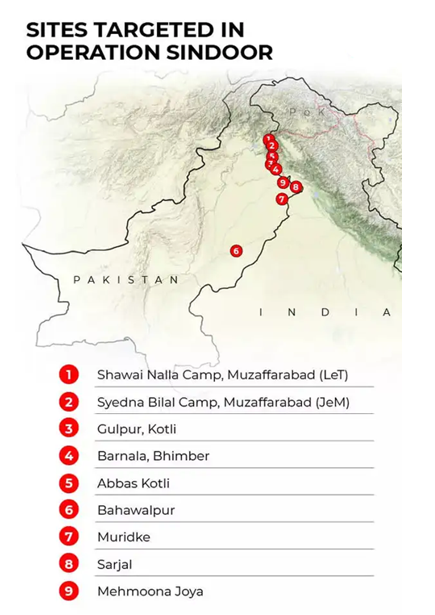In this blog, we will discuss Operation Sindoor—India’s latest high-precision military response to terrorism, launched on 7th May 2025 following the brutal Pahalgam attack. This operation not only demonstrates India’s growing military and technological capabilities but also carries profound symbolic meaning by honoring the sacrifices of the victims. From the deployment of advanced weaponry like SCALP missiles and HAMMER bombs to the prominent leadership roles of women officers, Operation Sindoor marks a turning point in India’s counter-terrorism doctrine.
Why in News?
India launched Operation Sindoor on 7th May 2025 in retaliation for the April 2025 Pahalgam terrorist attack. This high-precision military operation targeted nine terrorist infrastructure sites located in Pakistan and Pakistan-occupied Jammu and Kashmir (PoJK). The operation marked another assertive step in India’s evolving counter-terrorism doctrine, combining military efficiency with symbolic messaging.
The operation briefing was notably led by Wing Commander Vyomika Singh and Colonel Sofiya Qureshi, underscoring the growing visibility of women in India’s defence leadership.
What is Operation Sindoor?
Operation Sindoor was a coordinated precision strike carried out by the Indian Armed Forces, involving the Army, Navy, and Air Force, and executed entirely from Indian soil. The objective was to neutralise terror facilities belonging to groups such as Jaish-e-Mohammed (JeM), Lashkar-e-Taiba (LeT), and Hizbul Mujahideen, which were being used to plan attacks against Indian interests.
Unlike past operations that bore aggressive names, Operation Sindoor was deliberately titled to invoke a deep emotional and cultural resonance. The term “Sindoor” (vermilion) symbolises the sacred marital mark worn by Hindu women. Following the Pahalgam attack, which left many women widowed, the name served as a tribute to the victims, especially the widows, turning grief into national resolve.
Precision Weaponry and Technological Superiority

The hallmark of Operation Sindoor was its high-precision weapon systems aimed at inflicting maximum damage with minimum collateral loss. The following advanced systems were deployed:
SCALP Cruise Missiles
Also known as Storm Shadow, these long-range, air-launched missiles were used for deep strikes against hardened and strategic targets. Developed by European firm MBDA, SCALP missiles were launched from India’s Rafale fighter jets. Known for their use in conflicts in Syria and Libya, they have now become a key asset in India’s aerial strike arsenal.
HAMMER Precision-Guided Bombs
Manufactured by Safran Electronics & Defense, HAMMERs (Highly Agile Modular Munition Extended Range) were used to target mobile and time-sensitive terrorist hideouts. These bombs are equipped with multiple guidance mechanisms—GPS, infrared, and laser—which allow them to engage diverse target profiles effectively.
Loitering Munitions (Kamikaze Drones)
These unmanned aerial platforms hovered over enemy territory, gathering real-time intelligence before executing autonomous strikes. Loitering munitions represent a modern warfighting concept, balancing surveillance with precision lethality while reducing risk to human operators.
Women at the Helm: A Defining Moment

The decision to have Colonel Sofiya Qureshi and Wing Commander Vyomika Singh lead the operation’s official briefing was widely lauded. This move symbolised ‘Nari Shakti’ in India’s defence narrative and reflected the institutional shift towards gender inclusivity in the armed forces. Their role highlighted not just competence, but a powerful counter-narrative to extremist ideologies that often subjugate women.
India’s Military Doctrine: Past Precedents
Operation Sindoor fits within a historical continuum of India’s calibrated military responses to cross-border aggression:
• Operation Riddle (1965): A response to Pakistan’s Operation Gibraltar during the 1965 war.
• Operation Ablaze (1965): A pre-emptive mobilisation signalling India’s readiness.
• Operation Cactus Lily (1971): Key military maneuver during the Bangladesh Liberation War.
• Operations Trident and Python (1971): Successful Indian naval attacks on Karachi harbor.
• Operation Meghdoot (1984): Secured control of the Siachen Glacier, ensuring high-altitude dominance.
• Operation Vijay (1999) and Operation Safed Sagar: Combined army-air force operations during the Kargil conflict.
• 2016 Surgical Strikes: Cross-LoC strikes following the Uri attack.
• Operation Bandar (2019): Air strikes on Balakot in response to the Pulwama attack.
These operations illustrate a doctrinal shift from restraint to calibrated retaliation, with a clear focus on precision and message control.
Conclusion
Operation Sindoor is not merely a military success; it is a strategic, symbolic, and social milestone. The operation underscores India’s evolving counter-terrorism policy—rooted in technological sophistication, surgical execution, and emotional resonance. It also highlights the increasing integration of women in high-stakes national security roles.
Read: Vizhinjam International Deepwater Port
Download App:










